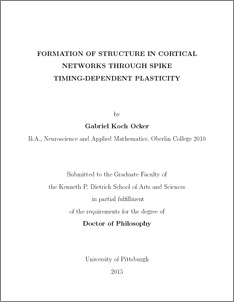Ocker, Gabriel
(2016)
Formation of Structure in Cortical Networks through Spike Timing-Dependent Plasticity.
Doctoral Dissertation, University of Pittsburgh.
(Unpublished)
![[img]](http://d-scholarship.pitt.edu/style/images/fileicons/application_pdf.png)  Preview |
|
PDF (Dissertation, Gabriel Kock Ocker)
Primary Text
Download (7MB)
|
Abstract
The connectivity of mammalian brains exhibits structure at a wide variety of spatial scales, from the broad (which brain areas connect to which) to the extremely fine (where synapses form on the morphology of individual neurons). Two striking features of the neuron-to- neuron connectivity are 1) the strong over-representation of multi-synapse connectivity pat- terns compared to simple random-network models and 2) a strong relationship between neurons’ local connectivity and their stimulus preferences, so that local network structure plays a large role in the computations neurons perform. A central question in systems neu- roscience is how such structures emerge. Answers to this question are confounded by the mutual interactions of neuronal activity and neural network structure. Patterns of synaptic connectivity influence neurons’ joint activity, while the synapses between neurons are plastic and strengthen or weaken depending on the activity of the pre- and postsynaptic neurons. In this thesis, I develop a self-consistent framework for the coevolution of network struc- ture and spiking activity. Subsequent chapters leverage this to develop low-dimensional sets of equations that directly describe the plasticity of connectivity patterns in large spiking networks. I examine plasticity during spontaneous activity and then how the structure of external stimuli can shape network structure and subsequent spontaneous plasticity. These studies provide a step towards understanding how the structure of neuronal networks and neurons’ joint activity interact to allow network computations.
Share
| Citation/Export: |
|
| Social Networking: |
|
Details
| Item Type: |
University of Pittsburgh ETD
|
| Status: |
Unpublished |
| Creators/Authors: |
|
| ETD Committee: |
|
| Date: |
21 January 2016 |
| Date Type: |
Publication |
| Defense Date: |
18 September 2015 |
| Approval Date: |
21 January 2016 |
| Submission Date: |
2 October 2015 |
| Access Restriction: |
No restriction; Release the ETD for access worldwide immediately. |
| Number of Pages: |
162 |
| Institution: |
University of Pittsburgh |
| Schools and Programs: |
Dietrich School of Arts and Sciences > Neuroscience |
| Degree: |
PhD - Doctor of Philosophy |
| Thesis Type: |
Doctoral Dissertation |
| Refereed: |
Yes |
| Uncontrolled Keywords: |
synaptic plasticity, neuronal networks, theoretical neuroscience, computational neuroscience |
| Related URLs: |
|
| Date Deposited: |
21 Jan 2016 21:31 |
| Last Modified: |
15 Nov 2016 14:30 |
| URI: |
http://d-scholarship.pitt.edu/id/eprint/26169 |
Metrics
Monthly Views for the past 3 years
Plum Analytics
Actions (login required)
 |
View Item |








